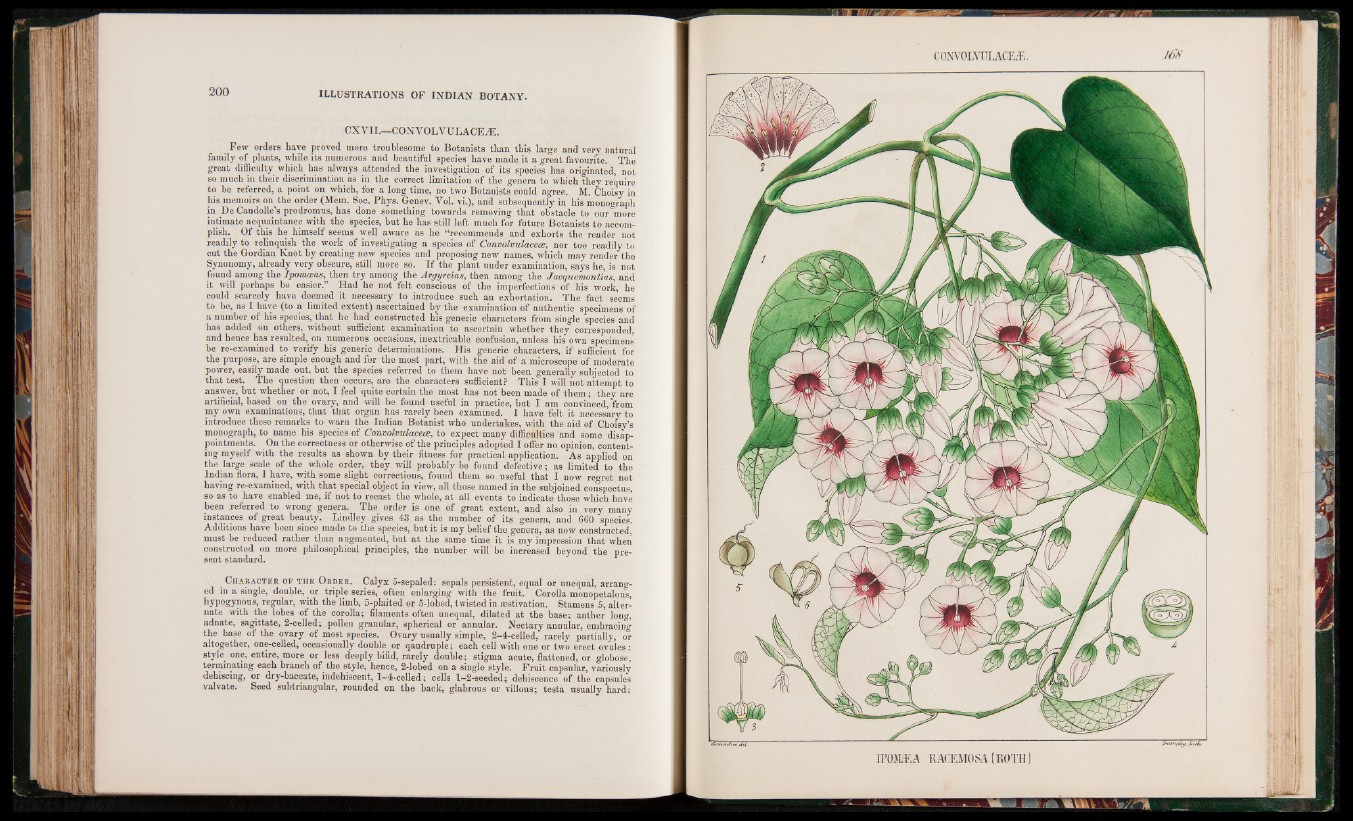
CXVII.—CONVOLVULACEHL
Few orders haye proved more troublesome to Botanists than this large and very natural
family of plants, while its numerous and beautiful species have made it a great favourite. The
great difficulty which has always attended the investigation of its species has originated, not
so much in their discrimination as in the correct limitation of the genera to which they require
to be referred, a point on which, for a long time, no two Botanists could agree. M. Choisy in
his memoirs on the order (Mem. Soc. Phys. Genev. Vol. vi.), and subsequently in his monograph
in De Candolle’s prodromus, has done something towards removing that obstacle to our more
intimate acquaintance with the species, but he has still left much for future Botanists to accomplish.
Of this he himself seems well aware as he “recommends and exhorts the reader not
readily to relinquish the work of investigating a species of Convolvulacece, nor too readily to
cut the Gordian Knot by creating new species and proposing new names, which may render the
Synonomy, already very obscure, still more so. If the plant under examination, says he, is not
found among the Ipomceas, then try among the Jrgyreias, then among the Jacquemontias, and
it will perhaps be easier.” Had he not felt conscious of the imperfections of his work, he
could scarcely have deemed it necessary to introduce such an exhortation. The fact seems
to be, as I haye (to a limited extent) ascertained by the examination of authentic specimens of
a number of his species, that he had constructed his generic characters from single species and
has added on others, without sufficient examination to ascertain whether they corresponded,
and hence has resulted, on numerous occasions, inextricable confusion, unless his own specimens
be re-examined to verify his generic determinations. His generic characters, if sufficient for
the purpose, are simple enough and for the most part, with the aid of a microscope of moderate
power, easily made out, but the species referred to them have not been generally subjected to
that test. The question then occurs, are the characters sufficient? This I will not attempt to
answer, but whether or not, I feel quite certain the most has not been made of them; they are
artificial, based on the ovary, and will be found useful in practice, but I am convinced, from
my own examinations, that that organ has rarely been examined. I have felt it necessary to
introduce these remarks to warn the Indian Botanist who undertakes, with the aid of Choisy’s
monograph, to name his species of Convolvulacece, to expect many difficulties and some disappointments.
On the correctness or otherwise of the principles adopted I offer no opinion, contenting
myself with the results as shown by their fitness for practical application. As applied on
the large scale of the whole order, they will probably be found defective; as limited to the
Indian flora, I have, with some slight corrections, found them so useful that I now regret not
having re-examined, with that special object in view, all those named in the subjoined conspectus,
so as to have enabled me, if not to recast the whole, at all events to indicate' those which have
been referred to wrong genera. The order is one of great extent, and also in very many
instances of great beauty. Lindley gives 43 as the number of its genera, and 660 species.
Additions have been since made to the species, but it is my belief the genera, as now constructed,
must be reduced rather than augmented, but at the same time it is my impression that when
constructed on more philosophical principles, the number will be increased beyond the pre-
sent standard.
# Ch a r a c t e r o f t h e O r d e r . Calyx 5-sepaled: sepals persistent, equal or unequal, arranged
in a single, double, or triple series, often enlarging with the fruit. Corolla monopetalous,
bypogynous, regular, with the limb, 5-plaited or 5-lobed, twisted in aestivation. Stamens 5, alternate
with the lobes of the corolla; filaments often unequal, dilated at the base; anther long,
adnate, sagittate, 2-celled; pollen granular, spherical or annular. Nectary annular, embracing
the base of the ovary of most species. Ovary usually simple, 2-4-celled, rarely partially, or
altogether, one-celled, occasionally double or qaudruple; each cell with one or two erect ovules;
styte one, entire, more or less deeply bifid, rarely double; stigma acute, flattened, or globose,
terminating each branch of the style, hence, 2-lobed on a single style. Fruit capsular, variously
dehiscing, or dry-baccate, indehiscent, 1-4-celled; cells 1-2-seeded; dehiscence of the capsules
valvate. Seed subtriangular, rounded on the back, glabrous or villous; testa usually hard;
MSEflV Vrm'Jm
C O O T 0 L V U L A C E Æ .
m n
IP0ÎLEA MCEMOSA (ROTH)
JhtrnfOvf'Z'uh,'
fL à -mm . n